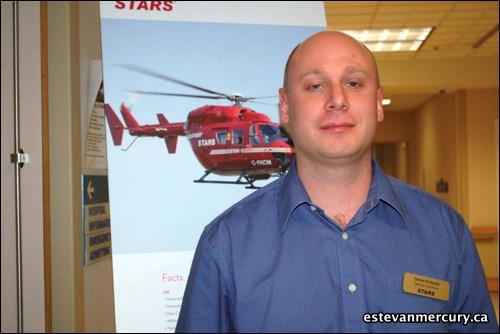A new link in the survival chain is about to be implemented in Saskatchewan.
The Shock Trauma Air Rescue Society (STARS) is becoming a reality with two medically equipped emergency response helicopters being prepared for deployment throughout the province by next spring.
But the service is much more than just airlifting patients using helicopters, said Daniel Kobylak, a flight paramedic and lead for clinical operations with STARS.
Kobylak is one of several STARS employees who are currently making tours throughout Saskatchewan learning and listening as well as letting local first responders know more about the service they will provide.
"I'm here to let the local police, firefighters, conservation officers, medical technicians, doctors, nurses, know who we are and what we can do," Kobylak said prior to his presentation to local emergency response team members who had gathered in the St. Joseph's Hospital auditorium on Wednesday evening for an introductory workshop.
"It's not just about helicopters," he said. "Education is a big component ... for responders as well as patients. It's about providing better care in the rural areas. We have a mobile education unit. We can help others who have to deal with septic cases, cardiac arrests or something they may not see a lot of. We can help them learn more about new lines of medication. So it's not just about evacuation of a patient by helicopter," he added.
But the helicopters are what everyone seems to be focusing on right now and they will be a huge component of the additional service.
"We're going around now, learning more about the communities we'll be serving and learning what they can do, who will be involved in medical evacuations, who are the attending physicians and what's going to be going on when we arrive?" Kobylak said.
Timelines will be an important cog in rescue operations that will enhance the already existing medical evacuation services using road ambulances and fixed wing aircraft.
"The helicopters can fly at around 250 kilometres per hour, so a response to Estevan from the Regina base would be 45 to 50 minutes, depending on weather and wind conditions," he said, as an example. It's what will be going on in the interim, that will be of interest to the 'copter team as they prepare to put down at the local hospital or fields.
"Early evacuation can be vital, down times are important, how the dispatch centres work is important, fear of the unknown is important, critical-care systems are important. It's all part of a team effort and we just augment existing services ... filling the gap if you will," Kobylak said.
The seminar in Estevan would help local responders learn when it will be appropriate to utilize the helicopter.
"We've been in existence in Alberta for 26 years. We provided some flood relief assistance in Manitoba last spring and they've asked us to stay so we're in negotiation with them now," Kobylak said.
In Saskatchewan, the contract is already signed with Crescent Point, an oilfield production leader that is also being a leading contributor to the cause, along with the provincial government.
Two helicopters will be in use at first, with a third added a little later.
When all personnel are in place, STARS will be employing as many as 100 people at each point (Regina and Saskatoon). On the medical front alone, there will be about 22 people filling full-time and part-time positions.
"This is a non-profit/charitable operation so we also have a fundraising foundation arm as well to help raise funds so we can continue to help people," said Kobylak in closing.



